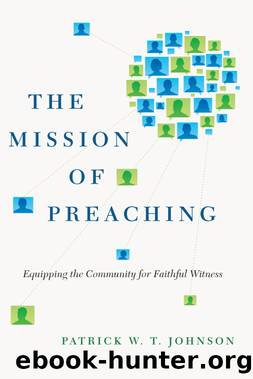The Mission of Preaching by Johnson Patrick W. T.;Lose David J.;

Author:Johnson, Patrick W. T.;Lose, David J.; [Johnson, Patrick W. T. ]
Language: eng
Format: epub
ISBN: 9780830897124
Publisher: InterVarsity Press
Published: 2015-02-16T00:00:00+00:00
Preaching Confesses Jesus Christ
We turn now to consider the essential activity in which preachers are engaged: confessing Jesus Christ. The homiletical proposals we explored earlier all operate within the general framework of âtestimonyâ and consider preaching a form of that activity. Long proposes preaching as bearing witness, connecting to Old and New Testament precedents and the hermeneutical work of Paul Ricoeur. However, he argues that the witness testifies and what the witness offers is a testimony. Thus, going back to Ricoeurâs courtroom analogy, Long appears to combine witness and testimony. Likewise, Anna Carter Florence describes âpreaching as testimonyâ and draws on the same material in Ricoeur. Influenced by Walter Brueggemann, she has much of the same Old Testament precedent in the background. Although she appears to prefer the term âtestimonyâ to âwitness,â like Long, Florence combines the two. By contrast, David Lose purposefully characterizes preaching as confession rather than witness or testimony, and the bulk of his work in Confessing Jesus Christ aims to develop âconfessionâ as a distinct concept for homiletical use. In my view, confession is the more appropriate category for missional preaching for several reasons.
First, there are the reasons Lose himself offers. While he does not compare âconfessionâ to other testimonial terms used in homiletics, he does argue that it is a useful term for at least four distinct reasons. First, ââConfessionâ designates a summary of the churchâs essential assertions concerning Godâs decisive activity in Jesus of Nazareth, the one crucified and raised from the dead.â24 Lose finds this aspect of confession important both in contemporary theology and in New Testament usage, especially in the post-Pauline documents, where homologein had evolved to signify both a doctrinal summary of the gospel and the essential tenets that distinguish orthodox from heterodox teaching.
Second, ââConfessionâ denotes articulating faith as a living response both to this proclaimed word and to the current situation and crisis of the world.â25 It is important here that confession is the articulation of faith in response to the challenge and crisis of the world because by this dimension of confession Lose draws a thin distinction in biblical usage between homologein (to confess) and martyrein (to bear witness). He writes, âFor whereas âwitnessingâ is most often self-consciously evangelistic in purpose, âconfessingâ reflects a stalwart declaring of what one believes, not simply toward the end of evangelistic persuasion, but also and especially because the circumstances demand it.â26
Third, confession is central to the life of faith and the life of the church. This insight is present in the New Testament usage and even more strongly in the work of theologians Miroslav Volf, Brian Gerrish and Douglas Hall, upon whom Lose relies.27 It is by confession, which is the essential summary and articulation of faith, that the community maintains its identity, learns its distinctive way of making meaning in the world, confers identity on individuals and responds to the questions and challenges posed by competing confessions. Finally and fourth, drawing on the speech-act theory of John Searle, Lose argues that confession
Download
This site does not store any files on its server. We only index and link to content provided by other sites. Please contact the content providers to delete copyright contents if any and email us, we'll remove relevant links or contents immediately.
Signature in the Cell: DNA and the Evidence for Intelligent Design by Stephen C. Meyer(2879)
Real Sex by Lauren F. Winner(2867)
The Holy Spirit by Billy Graham(2777)
The Secret Power of Speaking God's Word by Joyce Meyer(2754)
The Gnostic Gospels by Pagels Elaine(2399)
Jesus by Paul Johnson(2229)
Devil, The by Almond Philip C(2205)
23:27 by H. L. Roberts(2144)
The Nativity by Geza Vermes(2115)
Chosen by God by R. C. Sproul(2055)
All Things New by John Eldredge(2052)
Angels of God: The Bible, the Church and the Heavenly Hosts by Mike Aquilina(1869)
Angels by Billy Graham(1844)
The Return of the Gods by Erich von Daniken(1840)
Knowing God by J.I. Packer(1724)
Jesus of Nazareth by Joseph Ratzinger(1708)
Evidence of the Afterlife by Jeffrey Long(1705)
The Gnostic Gospel of St. Thomas by Tau Malachi(1680)
How To Be Born Again by Billy Graham(1670)
